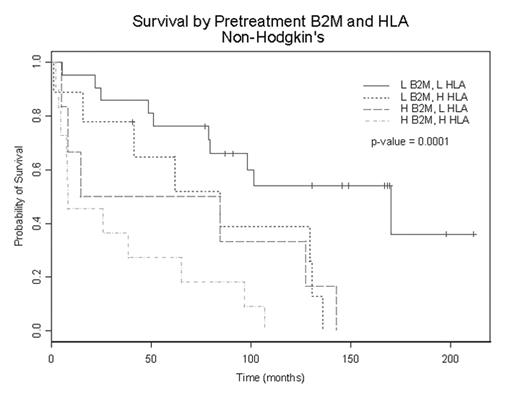Abstract
Higher levels of b-2 microglobulin (b2-M) have been reported to correlate with poor outcome in non-Hodgkin’s lymphoma (NHL) and Hodgkin’s disease (HD). However, b2-M is a subunit of the human leukocyte antigen-class I (HLA-I) molecule, which is composed of b2-M and the alpha heavy chain. Although soluble HLA-I (sHLA-I) protein has been detected in circulation and is believed to play a role in immunomodulation by inducing apoptosis in cytotoxic T-lymphocytes, the clinical relevance of sHLA-I levels in HD and NHL is not known. Here we report that serum sHLA-I levels are increased in NHL and HD. More importantly, levels of sHLA-I correlate with clinical behavior in NHL in a fashion similar to that of b2-M. In a multivariate model incorporating b2-M, sHLA-I, and IPI (International Prognostic Index), NHL patients with sHLA-I levels >312.60 mg/mL had significantly shorter survival than those with lower levels, independent of IPI score. Moreover, a model incorporating both sHLA-I (cut-point = 312.60 mg/mL) and b2-M (cut-point = 4.16 mg/L) levels were highly predictive of survival (Figure) in NHL patients. In contrast, in HD, b2-M levels correlated with clinical behavior whereas HLA-1 levels did not. These data not only establish the role of sHLA-I as an independent tumor marker in NHL that can be used to stratify patients, but also suggest that, in HD, b2-M and sHLA-I may reflect different processes. The role of sHLA-I as an immunomodulator may be responsible for its divergence from b2-M as an indicator of clinical behavior in HD. Further studies exploring the importance of this role in the biology of HD are needed.
Author notes
Corresponding author


